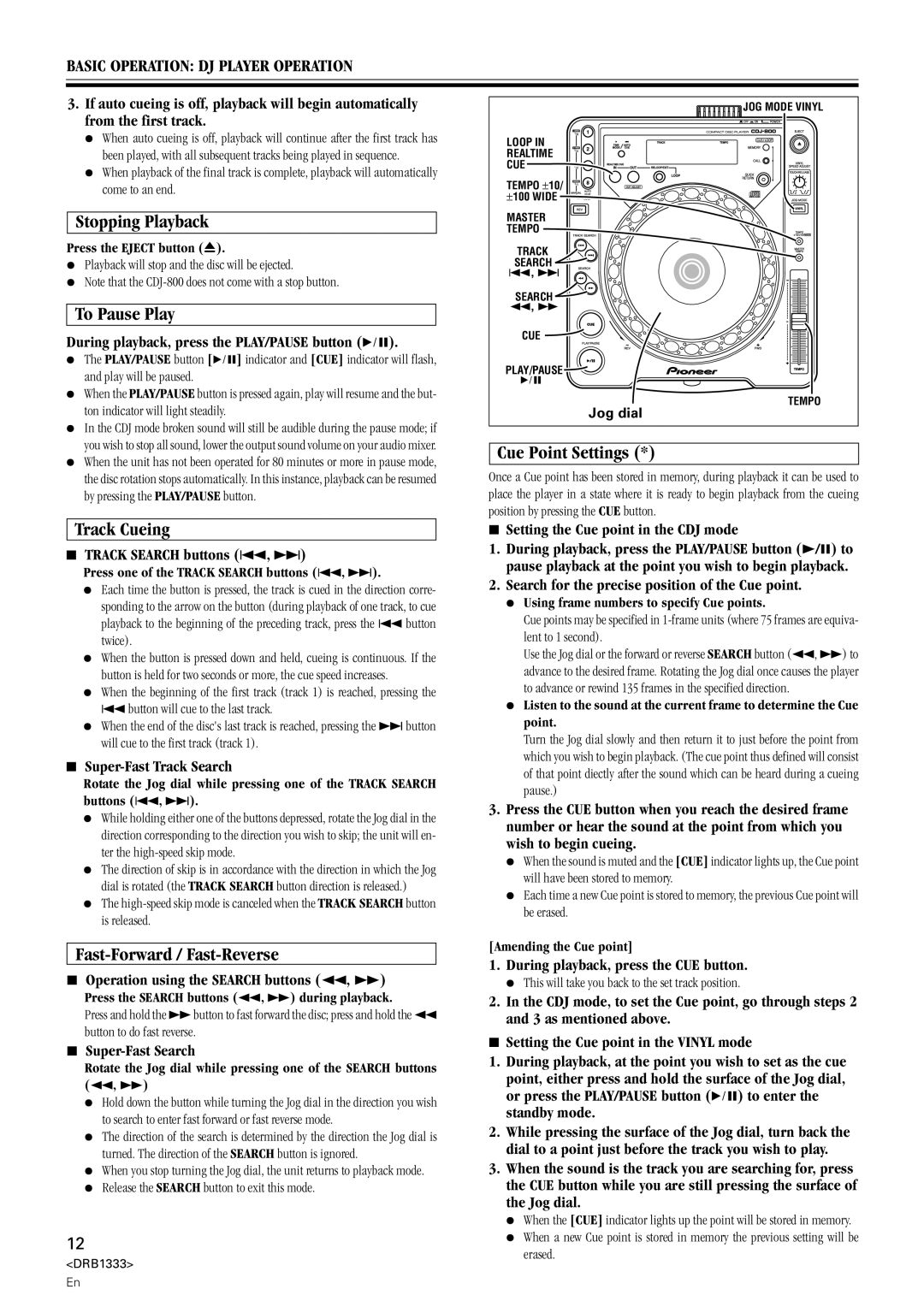3.If auto cueing is off, playback will begin automatically from the first track.
÷When auto cueing is off, playback will continue after the first track has been played, with all subsequent tracks being played in sequence.
÷When playback of the final track is complete, playback will automatically come to an end.
Stopping Playback
Press the EJECT button (0).
÷Playback will stop and the disc will be ejected.
÷Note that the CDJ-800 does not come with a stop button.
To Pause Play
During playback, press the PLAY/PAUSE button (6).
÷The PLAY/PAUSE button [6] indicator and [CUE] indicator will flash, and play will be paused.
÷When the PLAY/PAUSE button is pressed again, play will resume and the but- ton indicator will light steadily.
÷In the CDJ mode broken sound will still be audible during the pause mode; if you wish to stop all sound, lower the output sound volume on your audio mixer.
÷When the unit has not been operated for 80 minutes or more in pause mode, the disc rotation stops automatically. In this instance, playback can be resumed by pressing the PLAY/PAUSE button.
Track Cueing
7TRACK SEARCH buttons (4, ¢)
Press one of the TRACK SEARCH buttons (4, ¢).
÷Each time the button is pressed, the track is cued in the direction corre- sponding to the arrow on the button (during playback of one track, to cue playback to the beginning of the preceding track, press the 4 button twice).
÷When the button is pressed down and held, cueing is continuous. If the button is held for two seconds or more, the cue speed increases.
÷When the beginning of the first track (track 1) is reached, pressing the 4button will cue to the last track.
÷When the end of the disc's last track is reached, pressing the ¢button will cue to the first track (track 1).
7Super-Fast Track Search
Rotate the Jog dial while pressing one of the TRACK SEARCH buttons (4, ¢).
÷While holding either one of the buttons depressed, rotate the Jog dial in the direction corresponding to the direction you wish to skip; the unit will en- ter the high-speed skip mode.
÷The direction of skip is in accordance with the direction in which the Jog dial is rotated (the TRACK SEARCH button direction is released.)
÷The high-speed skip mode is canceled when the TRACK SEARCH button is released.
Fast-Forward / Fast-Reverse
7Operation using the SEARCH buttons (1, ¡)
Press the SEARCH buttons (1, ¡) during playback.
Press and hold the ¡button to fast forward the disc; press and hold the 1 button to do fast reverse.
7Super-Fast Search
Rotate the Jog dial while pressing one of the SEARCH buttons (1, ¡)
÷Hold down the button while turning the Jog dial in the direction you wish to search to enter fast forward or fast reverse mode.
÷The direction of the search is determined by the direction the Jog dial is turned. The direction of the SEARCH button is ignored.
÷When you stop turning the Jog dial, the unit returns to playback mode.
÷Release the SEARCH button to exit this mode.
12
<DRB1333>
En
 JOG MODE VINYL
JOG MODE VINYL
LOOP IN
REALTIME
CUE
TEMPO ±10/
±100 WIDE
MASTER
TEMPO
TRACK
SEARCH
4, ¢
SEARCH
1, ¡
CUE
PLAY/PAUSE
6
TEMPO
Jog dial
Cue Point Settings (*)
Once a Cue point has been stored in memory, during playback it can be used to place the player in a state where it is ready to begin playback from the cueing position by pressing the CUE button.
7Setting the Cue point in the CDJ mode
1.During playback, press the PLAY/PAUSE button (3/8) to pause playback at the point you wish to begin playback.
2.Search for the precise position of the Cue point.
÷Using frame numbers to specify Cue points.
Cue points may be specified in 1-frame units (where 75 frames are equiva- lent to 1 second).
Use the Jog dial or the forward or reverse SEARCH button (1, ¡) to advance to the desired frame. Rotating the Jog dial once causes the player to advance or rewind 135 frames in the specified direction.
÷Listen to the sound at the current frame to determine the Cue point.
Turn the Jog dial slowly and then return it to just before the point from which you wish to begin playback. (The cue point thus defined will consist of that point diectly after the sound which can be heard during a cueing pause.)
3.Press the CUE button when you reach the desired frame number or hear the sound at the point from which you wish to begin cueing.
÷When the sound is muted and the [CUE] indicator lights up, the Cue point will have been stored to memory.
÷Each time a new Cue point is stored to memory, the previous Cue point will be erased.
[Amending the Cue point]
1.During playback, press the CUE button.
÷ This will take you back to the set track position.
2.In the CDJ mode, to set the Cue point, go through steps 2 and 3 as mentioned above.
7Setting the Cue point in the VINYL mode
1.During playback, at the point you wish to set as the cue point, either press and hold the surface of the Jog dial, or press the PLAY/PAUSE button (6) to enter the standby mode.
2.While pressing the surface of the Jog dial, turn back the dial to a point just before the track you wish to play.
3.When the sound is the track you are searching for, press the CUE button while you are still pressing the surface of the Jog dial.
÷When the [CUE] indicator lights up the point will be stored in memory.
÷When a new Cue point is stored in memory the previous setting will be erased.

